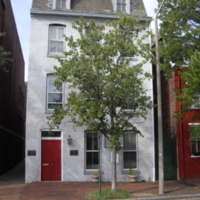
Freedom House Museum
The Freedom House Museum was once part of the headquarters for the largest domestic slave trading firm in the United States, Franklin and Armfield. Enslaved Africans were brought from the Chesapeake Bay area and forced to the slave markets in Natchez, Mississippi and New Orleans either by foot or ship. The building has a long history. In 1828, it was leased by Isaac Franklin and John Armfield and used as a "Negro Jail" or slave pen for slaves being shipped from Northern Virginia to Louisiana. During the American Civil War the museum and its surrounding sites were used firstly as a military prison for deserters, then as the L'Ouverture Hospital for black soldiers, and finally as the barrack for contraband-slaves who fled the confederate states and sought refuge with Union troops.
The building is currently owned by the Northern Virginia Urban League but the museum is managed by the office of Historic Alexandria. It operates as a reminder to the people of Alexandria of the city's role in historic slavery.
In the basement of the building there is a powerful exhibition which depicts the harsh reality of the domestic slave trade and Alexandria's role in it, through the use of first person narratives from enslaved men and women. These are complemented with a range of contextual text panels, artefacts, images and maps.

Knaresborough Festival of Entertainment and Visual Arts, 2007
Historian Audrey Dewjee gave a talk on the Yorkshire links with slavery, abolition and emancipation during Knaresborough's annual Festival of Entertainment and Visual Arts in 2007, entitled 'Merchants, Plantations and Slave Traders'.
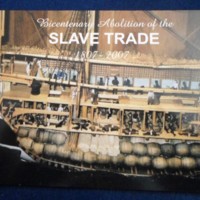
Response of Jacqueline and Sonia Brooks
As descendants of enslaved Africans, Jacqueline and Sonia Brooks expressed their own independent responses to the bicentenary. Jacqueline designed a limited edition postcard to display the horrors of a slave ship. Sonia wrote the poem Amazing Trade, which was performed during the National Maritime Museum's programme for Slavery Remembrance Day.
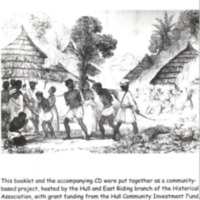
Songs of Slavery
The Songs of Slavery CD and booklet were produced by a community-based project, led by the Hull and East Riding branch of the Historical Association. The project was part of the Wilberforce 2007 initiative in Hull. Songs of Slavery recorded 19 songs relating to slavery, alongside six short narratives. Most of the songs date from the mid-19th century and were originally composed and sung by enslaved peoples. Some were based on religious beliefs, others also contained coded messages to aid escape and resistance. The Songs of Slavery tracks were sung or narrated by local choirs, singers and musicians, together with students from local schools and colleges.
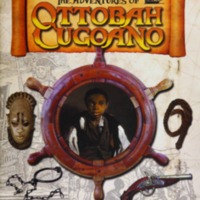
The Adventures of Ottobah Cugoano
The Adventures of Ottobah Cugoano is a book written for young readers, written by Marcia Hutchinson and Pete Tidy, and published by Primary Colours as part of the Freedom and Culture 2007 initiative. Ottobah Cugoanao was an African abolitionist, captured in 1770 in Fante (present-day Ghana) and sold into slavery. He was eventually made free and baptized John Stuart in London. Stuart became active in Sons in Africa and through his publications campaigned for abolition. A Key Stage 2 and Key Stage 3 Teaching Pack was produced to accompany the adventure story, written by Marcia Hutchinson, Pete Tidy and Shazia Azhar, with a foreword by David Lammy MP.
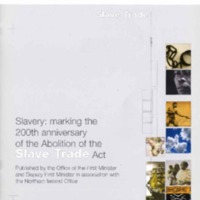
Slavery: marking the 200th anniversary of the Abolition of the Slave Trade Act
The official publication from the Office of the First Minister and Deputy First Minister in association with the Northern Ireland Office, based on the research of historian Nini Rodgers.
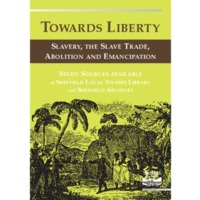
Towards Liberty: Slavery, the Slave Trade, Abolition and Emancipation
This booklet was produced to mark the bicentenary in 2007 and to highlight the material available in Sheffield Local Studies Library and Sheffield Archives for the study of slavery, the slave trade, abolition movements and emancipation. It looks, in particular, at the role of the city of Sheffield and the surrounding areas, and its local residents. Sheffield benefited from the slave system in that goods manufactured in the city's factories were used on the plantations in the West Indies and America. Sugar and coffee produced on the plantations was consumed by residents. There were active anti-slavery groups in Sheffield, including the Ladies Anti-Slavery Society, and petitioning and boycotts were common. Hannah Kilham, a Sheffield Quaker, published a memoir of her experiences in West Africa as a teacher in the 1820s and 1830s.
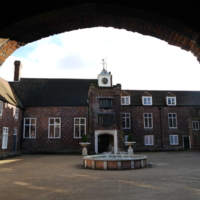
Faces of Freedom: Hammersmith and Fulham and the Slave Trade
The Museum of Fulham Palace is housed in the former palace of the Bishops of London, and former home of Bishop Porteus, the leading advocate for abolition within the Church of England in the late 18th and early 19th centuries. The Faces of Freedom exhibition featured Porteus alongside other individuals associated with slavery and abolition who had links with the area. The abolitionist Granville Sharp lived and is buried nearby, while Crisp Road was named after the slave trader and bead manufacturer Sir Nicholas Crisp. The exhibition included glass beads (very likely produced to be used for barter in Africa) excavated by the Museum of London on the site of Crisp's Hammersmith home. Also featured was the story of Ellen and William Craft, fugitive slaves from Georgia who made Hammersmith their home, and the contributions of local residents Marcus Garvey, Jamaican Pan-Africanist, and nurse Mary Seacole. The exhibition included video footage and posters relating to slavery and freedom, created by pupils from the nearby Phoenix High School.
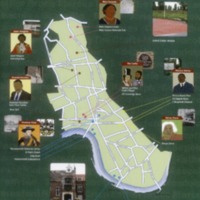
Remembering Slavery in Hammersmith and Fulham
Hammersmith and Fulham Urban Studies Centre is a voluntary educational organisation which offers opportunities to children and young people to learn about the local urban environment. The online curriculum resource 'Remembering Slavery' aimed to inform teaching and learning about the transatlantic slave trade by tracing the links of people and places in Hammersmith and Fulham to enslavement, the slave trade and its abolition. It explored the lives of enslaved Africans and their descendants, detailing their experiences and contributions in the local area. The resource aimed to encourage teachers to develop a locally-based Black history focus across curriculum programmes. It consisted of resource guides and animated films across four broad time frames: pre-Victorian, Victorians, Britain in the 1930s and 40s, and Britain since 1948.
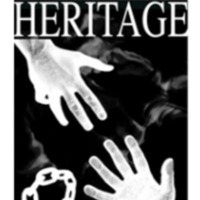
Dark Heritage
Dark Heritage from Bee Arts Community Interest Company comprised The DARK, a sonic art installation, and accompanying participatory educational activities. The DARK touring installation is a pitch black space designed to bring home the horrors of the transatlantic slave trade in the 18th century. The three dimensional soundscape uses ghosts as metaphors for the hidden aspects of the past, based on the Liverpudlian slave-ship worker Edward Rushton, slave ship Captain John Newton, and Kunie, an African man who met Rushton aboard an American ship. A programme of public sessions and creative educational workshops aimed at schools, colleges, youth and community groups were produced in collaboration with Kingswood Primary School in Lambeth. Dark Heritage travelled to six locations in the UK in 2007-08 starting in Greenwich, travelling to Ipswich, Gloucester, University of Hertfordshire, Norwich and finishing in Manchester.
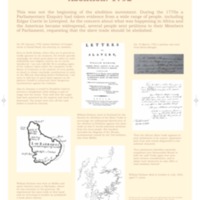
Dumfries and Galloway and the Transatlantic Slave Trade
An exhibition exploring the connections between the Scottish region of Dumfries and Galloway and the transatlantic slave trade toured Dumfries Museum, the Stewartry Museum in Kirkcudbright and Stranraer Museum. At each venue, the exhibition was accompanied by displays of material and a lecture. The catalogue of new research to supplement the exhibition by Frances Wilkins set out to correct misunderstandings about the role of people from the region in the transatlantic slave trade, to prove a history of connections independent of Glasgow or anywhere else. Evidence suggests that men from smaller towns such as Dumfries and Kirkcudbright were involved in the transatlantic slave trade as merchants, slave traders or plantation owners. For example, in the late 18th century, plantation supplies were sent from Kirkcudbright to the island of Grenada; the vessels returned with rum, sugar, and cotton wool.
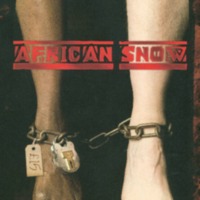
African Snow: Secrets of the Trade
In conjunction with York Theatre Royal, Riding Lights Theatre Company produced a new play written by Murray Watts, directed by Paul Burbridge, with original music by Nigerian musician Ben Okafor. African Snow: Secrets of the trade was originally commissioned by the Church Mission Society, an organisation founded in 1799 by representatives of the abolition movement, including William Wilberforce. The play sought to explore the ideas associated with antislavery and how they can be put to use in the modern day campaign for the end of slavery. Opening at York, the play went on to have a West End Transfer followed by a national tour. The main characters are John Newton, the converted slave-trader who later wrote 'Amazing Grace', and the former slave and abolitionist Olaudah Equiano. The play saw them confronting each other’s differing perspectives, creating a dialogue in which the audience could witness alternative views towards slavery. A 'snow' was a class of ship, commonly used for the transportation of slaves. 'The African' was the first slave ship on which John Newton sailed.
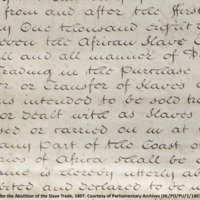
Guernsey and the Slave Trade
A display in the entrance foyer of Guernsey Museum in 2007 explored the island's connections with slavery and the slave trade. Relevant items from the museum's collection included a slave collar and chain from a slaver intercepted by a Guernsey captain on anti-slavery patrols, and a 17th-century portrait of Anne de Beauvoir and a slave child. Guernsey was involved in the transatlantic slave trade via islanders directly involved in the traffic (for example, Thomas Ebworthy of the ship 'Anne Galley'); ships known to be involved, such as the 'African' and the 'Fanny'; and islanders' involvement with the supply of goods or services.
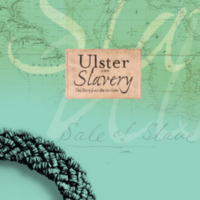
Hidden Connections: Ulster and Slavery 1807-2007
The Hidden Connections exhibition was a result of partnership between the Public Record Office of Northern Ireland (PRONI) and the Linen Hall Library in Belfast. The exhibition explored Ulster's links with slavery after 1807 via people, events and places, and looked at both the pro and anti-slavery debates in Northern Ireland. It drew on documents from PRONI’s archives, artefacts from the Ulster Museum and contemporary books and pamphlets from the Linen Hall Library and elsewhere. After its launch at Linen Hall Library, the exhibition toured Northern Ireland, travelling to Down Museum, the Harbour Museum in Derry, Lisburn City Library and the Ulster American Folk Park.
The wider Hidden Connections programme featured workshops exploring archival sources, performances and lectures by leading scholars. There was a panel discussion on ‘Slavery Now’, a walking tour of Belfast sites associated with the slavery issue, and a boat trip on the Lagan focusing on the port’s links with slave colonies. Gerry McLaughlin’s ‘Blood sugar’ is a drama documentary devoted to the literature of slavery, music and song. 'Freedom and Liberty' was the theme of the UK-wide Archives Awareness Event. PRONI organised special events and produced a catalogue, 'Ulster and Slavery', listing the references to slavery to be found in the archive.
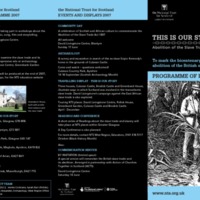
This is Our Story
To mark the bicentenary, the National Trust for Scotland put together a wide-ranging programme of events to engage their audiences with Scottish connections to slavery and abolition. Three National Trust for Scotland properties in the West of Scotland – Culzean Castle, Brodrick Castle and Greenbank House – illustrate the ways in which Scotland was involved in the transatlantic slave trade. A touring exhibition based on this new research was shown at these sites and others in the West of Scotland. The Beckford Collection of furniture, silver and China at Brodrick Castle, on the Isle of Arran, once belonged to William Beckford, owner of several sugar plantations in the West Indies. Scipio Kennedy from ‘Guinea’ lived at Culzean Castle, Ayrshire, from 1710, first as a slave and then as a paid servant. The Allason brothers of Greenbank House were traders in tobacco and slaves. David Livingstone spent much of his life campaigning against the slave trade based in East Africa. His work is remembered at the David Livingstone Centre in Blantyre.
The 2007 Learning Programme involved workshops for local community groups and a resource pack for teachers and youth leaders. Events included a celebration of Scottish and African culture at the David Livingstone Centre; a survey and excavation in search of the ex-slave Scipio Kennedy’s home in the grounds of Culzean Castle; and a Commemoration Service arranged in partnership with Action of Churches Together in Scotland (ACTS).
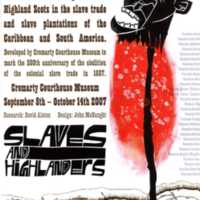
Slaves and Highlanders
An exhibition developed by Cromarty Courthouse Museum in the Scottish Highlands recording the role of Highland Scots in the slave trade and slave plantations of the Caribbean and South America and, in particular, British Guiana. The striking illustrations were by John McNaught. The exhibition told individual stories of Scottish merchants, plantation owners and their slaves, such as a slave called Inverness, bought, sold, exploited and hunted as a runaway by Scots in Demerara. It also looked at the freed slaves who found a place in Scottish society. Connected to this project was the placing of a plaque in the former Royal Northern Infirmary (now the executive office of the University of the Highlands and Islands). It remains one of the few acknowledgements of the use of profits from the slave plantations to fund charitable public institutions, and the only known one in Gaelic.
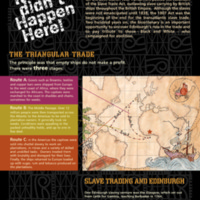
It Didn't Happen Here! Edinburgh's Links in the Trans-Atlantic Slave Trade
This exhibition at the Museum of Edinburgh explored the city's links to the slave trade and, in particular, trading connections with the Americas. Imports to the Port of Leith from North America and the West Indies included tobacco, rum, sugar, cotton, rice and indigo. The exhibition looked at Scots who sought fortunes in the West Indies, as well as Black residents who made their homes in Edinburgh. It also explored Edinburgh's connections to the abolition movement.
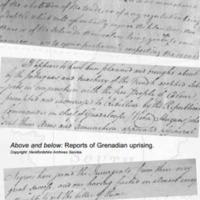
Unfair Trade
A touring exhibition from Herefordshire Museums, which explored Herefordshire's hidden history of slavery. Local connections include Moccas Court near Hereford, the country house once home to the Cornewall family, owners of a sugar plantation on Grenada at the time of the Grenadian uprising of 1795. Another county connection to the history of slavery is Lady Hawkins' School in Kington, the construction of which was bequeathed in 1632 by the widow of Sir John Hawkins, England's first slave trader. The nineteenth-century poet and abolitionist Elizabeth Barrett Browning also had family connections in Herefordshire. The exhibition was taken on tour around Herefordshire and Warwickshire on a specially commissioned Abolition Bus.
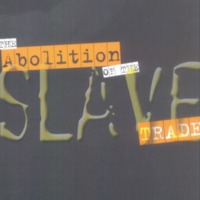
The Abolition of the Slave Trade
Kirklees Council ran a range of events in 2007, focused on local connections with slavery and abolition. Kirklees Civic Sunday was the official commemoration at Huddersfield Parish Church, with a performance by a local gospel choir and a presentation by actors as historical characters. The links between Yorkshire and the Caribbean were also explored: 8,500 people of African-Caribbean descent live in the borough of Kirklees. Events such as the Jamaica National Independence Cultural Festival, Deighton Carnival and Huddersfield Carnival celebrated African and Caribbean culture. Part of the Kirklees programme was to host the Equiano Project's touring exhibition at the Hudawi Centre in Huddersfield. The Centre went on to name one of its rooms after Equiano. Other events included talks from historians, including Richard Reddie and Paul Crooke, church services, choir concerts and theatre productions.
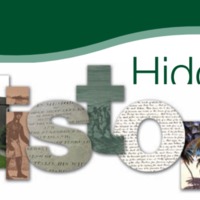
Hidden History of the Dales
This project was a collaboration between the Dales Countryside Museum in Hawes and North Yorkshire Record Office to research people and places of the Yorkshire Dales connected with Africa, the Caribbean and India. 'Hidden History' collected local stories of slave owners and traders, abolitionists, Africans and Asians who moved to the Dales, and others like the actor Ira Aldridge who passed through. The project included various community activities. Working with actor Joe Williams, pupils from the Wensleydale School explored the life of Olaudah Equiano and performed alongside Joe at the exhibition opening. There were drop-in sessions on exploring family history, carnival costume making, talks and music. The exhibition toured to other locations in Yorkshire, including Boroughbridge Library. The Dales Countryside Museum has continued to collect information relating to individuals who were connected with the Yorkshire Dales and the wider world.